From Habitat magazine - issue 06
With spectacular views over Waimanu Lagoon, the Waikanae River estuary and Kapiti Island out to sea, Rosemary and Laurie Petherick have created a home and garden in perfect harmony with a wonderful natural setting at Waikanae Beach.
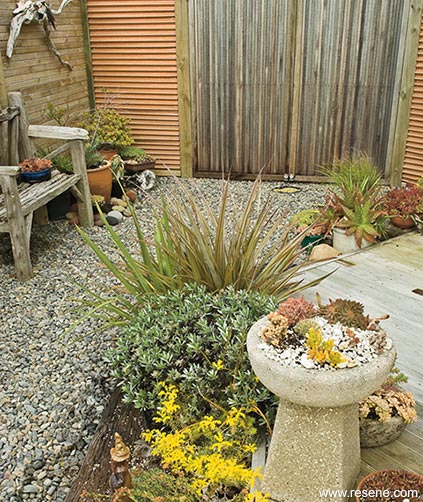
The couple wanted to make the home appear to “disappear” into the landscape – highlighting it as a house at the beach rather than a beach house. They succeeded by combining great designs for both the house and garden, and through the clever use of natural colours that echo the expansive views, from the ranges in the east to Kapiti Island in the west.
“These are colours that reflect the tones of the sand, grass, toe toe flags and the sky,” as Rosemary and Laurie say.
In January, 1995, the Pethericks, along with Rosemary’s sister and her husband, bought two neighbouring sections – chosen for their location and proximity to beach and river – with the aim of building retirement homes there in the future. The family has a long and memorable connection with this part of the country.
“Laurie’s family had a bach at Waikanae from 1949. We lived in Wanganui and holidayed every year with family at Waikanae, staying in a caravan parked on my sister’s original section,” Rosemary explains.
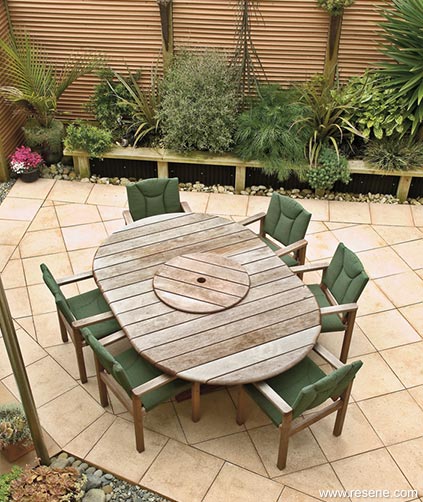
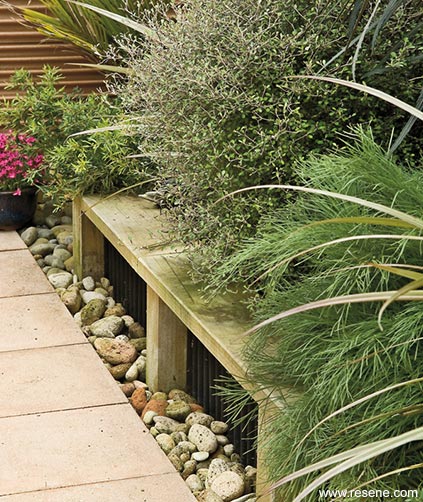
When they first bought the beach section, Rosemary and Laurie sketched out a ground floor layout themselves. The total design was completed in 1998 by architect Mark Southcombe, who was then based in Wanganui. The design includes attractive curved roofs to maximise height while keeping within building regulations, and views through the house offer amazing vistas from both levels across to the majestic ranges in the east and Kapiti Island in the west.
Construction of the new home was completed in December, 1999, with the couple celebrating the new millennium there. They have lived there permanently now since May, 2002. Happily settled in their home near the beach, Laurie says he enjoys the “uniqueness of location”. For Rosemary, it’s the same, really, but she describes it as: “the dramatic landscape that surrounds our home”.
The retired couple have always been keen gardeners. They lived in Wanganui for more than 30 years, where they developed a large garden, which was opened to the public on several occasions.
”There was a lot of hard landscaping initially – to shape a sloping section – and planting of shelter trees. This was followed by 80 camellias, a large number of native plants and trees, and an orchard and vegetable garden. During our last ten years there, we developed a gully with a native bush walk, pond, and a swamp area.”
While their garden at Waikanae Beach is very different in size, style and setting, and requires far less maintenance than the Wanganui property, the Pethericks have established an exceptional seaside showpiece here, after lots of careful planning and planting. Their garden has already been headlined in two leading publications, including one by the venerable gardening writer, Julian Matthews. It is a great example of successful coastal gardening, highlighting the use of plant species in an exposed, sandy, coastal environment. They have also hosted several visits from garden club groups.
The couple did all the design, hard graft in preparation, and planting of the garden areas themselves. This includes an overflow garden on the adjacent reserve, completed with the local council’s blessing.
“We designed the plantings to fit the landscape and also to soften the impact of the two-storeyed house, especially as it is viewed from the reserve next door.”
And, as Laurie says: “It’s great to get positive feedback from visitors and we enjoy the very sociable interaction with people walking past.”
Their work was not always easy, with the gardens bordering the river and sea, and open to high winds in this coastal zone. The beach garden on former sand dunes is exposed to wind and salt spray, while the lagoon waterfront eliminates the wind-blown sand that plagues nearby beachfront sections.
The new garden also had to accommodate fairly distinct climate conditions in different parts of the section. And the couple had to select appropriate plants to deal with drought conditions and water restrictions too. Bore water was used along with composting and mulching to establish the plants, but sand re-surfacing and water absorption continues to be a problem.
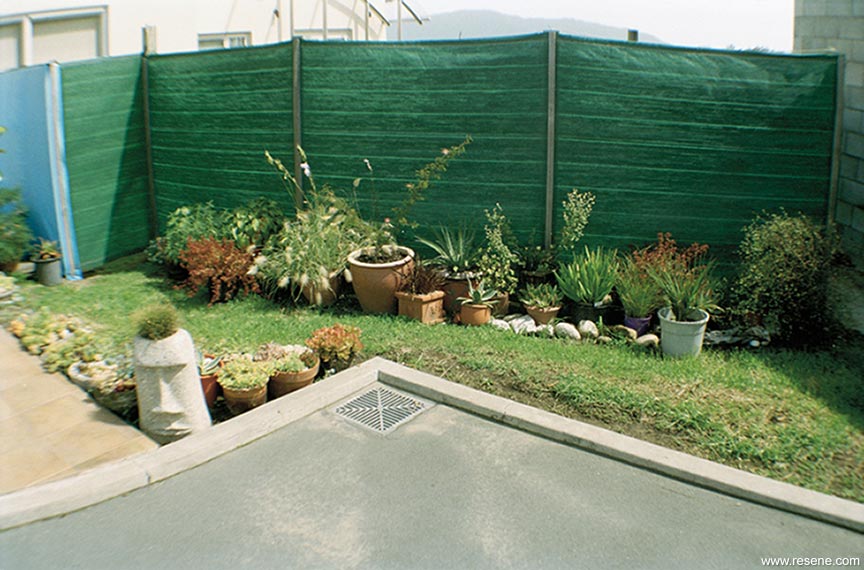
Rosemary and Laurie chose a variety of hardy species, with close planting for root support. They kept the setting natural, where possible, for the native plants, grasses and succulents. Specimens that have flourished in this seaside oasis include cordyline or cabbage trees, cycads (with some shelter), corokia, phormium or flaxes, muehlenbeckia, libertias and grasses, including carex, uncinia, festuca, amenanthele, chionochloa, miscanthus and poa. Other successful plants include euphorbia, genista, palms, coprosma, pohutukawa, olearia, hebes, and a huge selection of succulents and cacti.
“These have all proved they’re real survivors,” says Rosemary.
They have also incorporated a collection of materials collected from local beaches, including black volcanic rocks, pumice, driftwood, sponges and seashells. A haha retaining wall, which marks the boundary on two sides of the property, has been made from rustic railway sleepers. A large tufa ball water feature was sourced from Living Stone in Greytown.
The couple took advice from their architect on the colour scheme for the outside of the house, using Rockcote cladding painted with Resene Buff, along with Resene Olive Green on one wall and the entry screen. The exterior shade was chosen specifically to blend seamlessly into the colour of the backdrop, no matter what angle it is viewed from.
However, it’s been the painted courtyard wall that has attracted serious attention. Located on the northern side of the house, this is a well used retreat, the gates of which can also be opened up to the view in calm weather.
“Many locals have changed their fencing plans to copy ours. Some people – including an architect – thought it was copper and wondered how much it had cost,” laughs Laurie.
The fence is black Onduline, painted with a coat of acrylic primer, Resene Lustacryl and two coats of Resene Enamacryl Metallic tinted Resene Magma. It was applied by brush, but Laurie believes it would have been much quicker to spray it on, because of the stippled absorbent surface of the Onduline.
“The fence has been installed close to the exposed beach environment for nearly two years, and still looks like shiny new copper,” he says.
The wall plaque that looks so effective on the “copper” background is by potter, Bill Davies, who also lives at Waikanae Beach. There are also three Puna pots on the wall from Nurez Design in Tauranga.
As for future plans for the Waikanae garden, there’s no major change on the agenda.
“Just some tweaking, and the maintenance – weeding, mulching and some renewal or division of plants,” the Pethericks say.
That should leave plenty of time for Laurie to be down at the Waikanae River mouth at every opportunity kite-boarding – he claims it’s the best spot in Wellington – or out on his fishing boat. Rosemary enjoys helping other people with their gardens, as well as doing community voluntary work, walking, reading, sorting the family archives, and being a grandmother to one.
bold colour and lush planting create a relaxed tropical oasis
Melissa Grove, from Ambrosia Grove, suggests this alternative landscaping scheme:
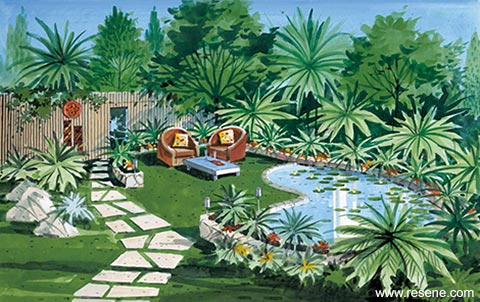
Organic and free-flowing forms, combined with natural materials, create an intimate feel in this tropical-inspired tea garden. The side entrance is disguised by a raised bed of polished stone. This embraces the lawn and the curved pond, joining a walkway of loose-format Indian sandstone. Lush foliage in different shades of green provides a dense border for privacy and harmony. The restful circle of lawn lends itself to entertaining, offering a seating area ideally suited to relaxed furniture and funky fabric. Cushions could be used to complement the bright colours of Calla lilies and bromeliads. Rocks, misters and recessed lighting add to the peaceful nature of this outdoor room.
Melissa Grove, Ambrosia Grove phone: 09 262 2188 email: melissa.grove@xtra.co.nz website: www.ambrosiagrove.co.nz
Accessories: Indian sandstone, from Designer Stone. Furniture Origin, from Interiors. Orange calla lilly. Dwarf red banana. Alocasia and pink bromeliad.
fun use of colour creates a romantic alfresco dining area
Yolanda Alba from Blooming Garden proposes this alternative garden design:
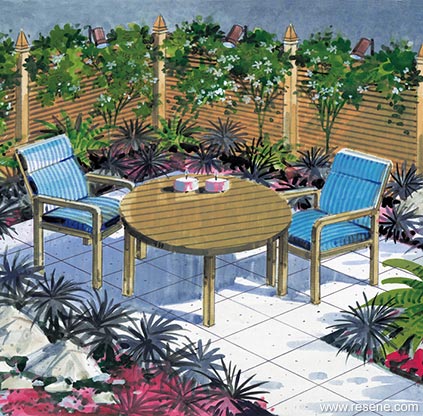
This simple, easy-care garden provides a romantic setting for alfresco dining. A backdrop of trellis fencing covered in fragrant, Star Jasmine replaces the corrugated iron wall at the rear of the space. The planting features contrasting tones of black, white, lime and pink. With its fuchsia flowers, the ground cover of Spanish Shawl is a low maintenance alternative to lawn and adds a bold accent. Black Mondo grass provides a border around a small square of grey paving stones, just large enough for a table for two. King Bromeliads with big lime-green leaves and tiger-like stripes introduce a touch of drama. The lighting, adjustable low-voltage copper fittings with blue tint filters, is mounted on top of the fence to illuminate the planting and cast romantic moonlight shadows across the paving.
Yolanda Alba, Blooming Garden phone: 09 630 3375 mobile: 021 634 595
Accessories: Paving, from Pierce Garden & Landscape Centre. King bromeliad, star jasmine, Spanish shawl, mondo grass, from Kings Plant Barn. Hunza lighting, from Jenny Pullar Landscape & Garden Design.
words: Robyn Yousef
pictures: Paul McCredie
illustration: Bruce Bryant
Search habitat magazine stories
Printed copies of habitat highlights are available from late March 2024 at Resene ColorShops and resellers, while stocks last. You can view back issues of habitat magazine online.
Specifiers:
If you have an idea, project or story that you think would suit habitat, we’d love to hear from you. Please drop us an email with your details and include photos if submitting a project.
Sign up for a DIY card and Save! Australia | New Zealand